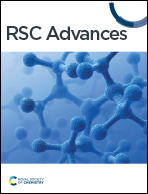Polyimide-derived porous carbon/Co particle-based composites for high-performance microwave absorption†
Abstract
A simple method that combines liquid–liquid phase separation and high-temperature pyrolysis has been developed for the synthesis of polyimide-derived porous carbon/Co particle-based composite absorbers (PIC/Co-800 and PIC/Co-1000). The excellent heat resistance of polyimide allows the composite precursor to maintain its porous structure during pyrolysis. According to the results, PIC/Co-800 and PIC/Co-1000 have a coral-like porous structure, which can enhance the impedance matching property and microwave attenuation ability of the synthesized materials. The impedance matching condition and dissipation ability of PIC/Co-800 and PIC/Co-1000 have been enhanced due to the synergistic effect between the carbon-induced dielectric loss and Co nanoparticle-induced magnetic loss. PIC/Co-1000 shows the highest absorption performance with a minimum reflection loss (RL) of −40.22 dB at a thickness of 5.3 mm and an effective absorption bandwidth (EABW, RL ≤ −10 dB) of 4.10 GHz at a thickness of 1.4 mm. With thicknesses in the range of 1.4 mm to 5.3 mm, the minimum RL value of each thickness is lower than −15 dB. Therefore, this work provides a new strategy for the synthesis of promising absorbing materials with outstanding EMW absorption performance.



 Please wait while we load your content...
Please wait while we load your content...